Paul Blanck in Kientzheim: in the heart of Alsatian wine country
August 4, 2013
By Panos Kakaviatos
At least since 2005, when I first visited Domaine Paul Blanck (great website, by the way) in the southern part of Alsace wine country, I have appreciated the quality and prices of wines from this excellent wine producer in the Haut Rhin, the lower – and more famous part – of Alsace. Many of the best terroirs can be found here. The domain’s website provides some great photos and descriptions of some of those terroirs HERE. Like many other families in Alsace, the Blanck family has been established in Alsace for hundreds of years, since the late 16th century and in the wine business in Kientzheim since the early 19th.
Today, two generations work hand in hand. While I do not know the older generation, sons Frédéric and Philippe Blanck whom I have both met work very hard to maintain the great quality of wines coming from some 36 hectares of vines with five grands crus accounting for more than a third. The terroirs reflect diversity, and an overall style of dry and pure Riesling.
Below a description of the terroirs and with some notes from wines tasted during a visit on Saturday, 3 August 2013. Wines I liked in particular in bold. Even more, in red. And when underlined, too, the most. By the way, HERE is a great page for general information – and a map – on Alsatian terroirs.
Join in on a discussion about this article on Wine Berserkers!
Terroirs and Rieslings tasted
Over the years, I have come to appreciate the Schlossberg terroir as one of my absolute favorites – also from other producers including Albert Mann and Weinbach. The Schlossberg has long been recognized as something special: it was indeed the first vineyard to officially become a grand cru in 1975, when Alsace began (much later than other French wine producing regions) to create a classification system. I have heard of plans to designate premiers crus. Already Alsace has 51 grands crus, and I have far from studied and tasted from all of them. There is a sense sometimes of “grand cru inflation” in part coming from the fact that yield limits are likely not low enough, permitting some producers to “dilute” the terroir. I wonder if all the grands crus merit grand cru status, and whether some should be premier cru, for example. But the Schlossberg raises no such doubts. It must be cultivated in terraces, since the steepness of the slope allows no other cultivation system. Facing south, its warm granites are fissured down by the race elements-and-sustenance-hungry roots. Granite brings such appealing freshness to the wines, which are also characterized by floral and vibrant citrus aromatics present in the first years, before minerality asserts its presence after 5 to 10 years of aging.
Paul Blanck makes some of the best Schlossberg Riesling money can buy. At only €15 per bottle at the property, this constitutes a tremendous bargain for wine lovers, as I again was able to taste on Saturday 3 August 2013 at the domaine. 2009 is not by any means the best vintage for Riesling in recent years, as it overall likely does not have the same freshness and vivacious nature of the 2010 vintage, which many are calling among the best in modern memory. 2008 is also magnificent. But I tried neither at the tasting, and the Paul Blanck Schlossberg Grand Cru Riesling 2009 was notable for its precision and richness, certainly the best of the Rieslings we tried with the possible exception of the Furstentum 2007, which comes from another grand cru terroir of another style, and from a rather better vintage – see next entry.
Paul Blanck also has vines in the the Furstentum grand cru, whose pebbly like calcareous soil is also south-facing with an up to 38% slope enhancing exposure to the sun. I have always had the impression, with generally all Furstentum Rieslings tasted also at other fine producers (again Albert Mann and Weinbach come to mind) of more richness. Indeed, some say that it affords ‘unique Mediterranean-like flora’. Full-bodied wines are being produced here. Complex and powerful aromas make them wines for aging, it is said, but I still hold a preference for the precision and freshness of Schlossberg. Having said that, the Paul Blanck Furstentum Grand Cru 2007 was very rounded and appealing, with notions of yellow peach – juicy ripe fruits – held together by good structure and acidity, with a feeling of depth and long finish. The richness was more evident here – with just a touch of warmth on the finish – than in the Schlossberg 2009, which seemed a bit more precise.
Paul Blanck also has vines at Wineck-Schlossberg. This grand cru has a full southern exposure in the heart of the Katzenthal dale. I get the impression, trying the Paul Blanck Wineck-Schlossberg Riesling 2009 of a wine that is perhaps too warm for its own good in that particular vintage. Remember that 2009 was a warm and sunny vintage and acidity levels are lower than in 2008 or 2010, or at least they seem less noticeable to tasters. That was the case here when compared to the Schlossberg.
We also tried a bottle of Paul Blanck Sommerberg Riesling Grand Cru 2008, for which I had high hopes. An intial nose was very promising, suggesting subtle and nuanced flavors. It is said that Sommerberg’s deeply weathered granite, exceeding 400 meters of elevation, with steep slopes up to 45%, produces wines that combine richness and freshness. But I think the bottle that we had tried had a cork issue which became more evident the longer the wine sat in glass. It is not for no reason that Paul Blanck has been moving increasingly towards screw cap enclosures, even for its grand crus wines.
In addition to grands crus, we tried other Rieslings, some from so-called lieu dits, or perhaps one could call them candidates for premiers crus? In any case, the Paul Blanck Patergarten Riesling 2009 conveyed a very pleasant iodine aspect, combined with notions of gunflint so often associated with Riesling. It was also a bit tar like, especially on the nose. What I really liked about this wine was its finesse on the palate and smooth texture and longish finish. Nice job, especially for a wine that costs €11.50 at the property. The gravely Patergarten is located in the gorgeous valley of Kaysersberg. The vineyards enjoy a microclimate allowing early ripening of the bunches. On the website of the domain, the wines are described as reflecting the “personality of the soil: light and forward” but I found some fine depth here too. A real bargain.
Also good was the Paul Blanck Rosenburg Riesling 2009, albeit not as focused as the Patergarten. Still, this exuded again a tar like nose, with kerosene rather than gunflint, preceding a lighter than expected palate, with a sweet lime like fruit. Just not as fine as the above, for the same price. Rosenbourg is located in nearby Riquewihr, facing southeast, with soils of chalk, silicea and silt, producing – according to the Paul Blanck website – “stout wines with a smoked touch typical of the named place”. I get the stout aspect!
I should not finish the Riesling section of this August tasting (pun intended 😉 without mentioning a very good Paul Blanck Riesling 2011, made from younger vines from all of the above, from grapes that could not cut it into either the lieu dits or the grands crus. I hesitated to give this a bold, but for the price – €9 at the property – this is a good deal, especially when one takes into account the somewhat flabby 2011 vintage…
Terroirs and Pinots Gris tasted
Now, I do not wish to upset anyone – least of all the great people at Domaine Paul Blanck – but this is a disclaimer of my personal taste. Too often critics and wine writers try to be “neutral” about wine styles that they may not like yet “should” respect. OK, I get that. But would I be honest if I did not write that – generally speaking – Pinot Gris in Alsace is my least favorite grape? Yes, even though it is a grand cru grape. Why? It tends to come off, too often, and even from top producers, as too thick and rich and sometimes over sweet for my tastes. Of course it depends on what you eat, too – see the notes below – but generally speaking, I am not a huge fan. So, with that in mind, here goes…
The Paul Blanck Pinot Gris 2011 (I think about €10 at the property) came across as over syrupy for my taste, with cloying aromas and a flabby palate. Again, I am not generally speaking a big fan of the grape… Then came the Paul Blanck Patergarten Pinot Gris 2011 for €12. A better terroir, as we saw with the Riesling, but, again, leaving a sweet impression that I found cloying. Perhaps the vintage had something to do with it? 2011 is somewhat flabby – from what I have tried – and combine it with a grape whose tendency can be flabby in the first place and here is what you can get…
It did get better though. For example, the Paul Blanck Wineck-Schlossberg Grand Cru Pinot Gris 2007. This is coming from a better vintage, more perceptible acidity and energy that balances out the richness of the Pinot Gris. The overall impression I got was of cleanness, purity and balance, even with elegance, within the confines of Pinot Gris. Also good was the Paul Blanck Furstentum Grand Cru Pinot Gris 2009. Although the nose was a bit cloying – again, perhaps this is just my personal taste – the palate conveyed perhaps the best body of all we tried, with excellent persistence on the finish. In discussing these wines with fellow tasters who were with me, notably Thomas Curtius and his wife Feodora Curtius – both professional tasters – we concluded that the grands crus were noticeably better than the previous wines, and that they could be particularly delicious when combined with certain foods. For example, rich foods with sauces could stand up to the richness of these two grands crus and accentuate their positive qualities. Of course lovers of Pinot Gris would find a certain nirvana here, too.
Terroirs and Gewürztraminers tasted
OK, now we get to my second favorite grape from Alsace. It completes the holy trinity of grapes in Alsace… While Pinot Gris seems to be – as the French say – entre deux chaises (between two chairs) – Gewürztraminer is proudly exuberant, spicy and unique. Yes, I have had bad versions, where you get aromatic caricatures of daisies and litchi fruit and – when really poor – a cough medicine feel on the palate. But we are at a very good producer here, so none of that I say!
Let’s just start with the best of them all, the Paul Blanck Furstentum Grand Cru Gewürztraminer 2008. The more I think of it, the more I like 2008 in Alsace. 2008 is a vintage of superb acidity – and, hence, energy, vibrancy, tension and vivacity. And white wines need it. More often than not. Certainly in Alsace, when fermentations generally leave residual sugars, even at the most dry oriented producers such as Trimbach. For a grape as exuberant and rich as Gewürztraminer, 2008 is magnifique. It has a lovely floral nose, very clean and pure, with excellent energy and opulence at the same time. Its old vines – at least 40 years old – lend the wine a certain gravitas. This wine would go very well with a roast chicken my mother always cooked when I was a child, prepared with pineapples! It could also go with Chinese sweet and sour dishes, for example. For €19 at the property, a good price. But another superb entry was the Paul Blanck Altenbourg Gewürztraminer 2008. For just €13 at the property, this wine is an excellent deal. It comes across as smoky and spicy, with notes of ginger, and its palate is of a smooth texture, with that 2008 tension, not ever over sweet. This would go very well with most cheeses. The Altenbourg has clay-like and chalky soil, located just below the grand cru Furstentum on the same south-facing hill.
One disappointment was the Paul Blanck Mambourg Grand Cru Gewürztraminer 2007. Mambourg vines grow on a calcareous foothill, the furthest into the plain of Alsace, facing south. Driving by the Route des Vins, one can see in large letters – like Hollywood – the letters Mambourg near the top of the slope. I have had other Mambourg based wines from other producers and they tend to be full bodied and elegant too. 2007, while not as rich as, say, 2009, was not as energetic a vintage as 2008 or 2010. Still, 2007 is a very good vintage. But this particular wine, for the same price as the Furstentum, came across as merely polite and even a bit flat on the palate. Not sure…
We also tried the basic Paul Blanck Gewürztraminer 2011, which, at just under €12, is not my first choice. Better to spend the extra bit of money for the Altenbourg 2008, as it is a far superior vintage. The somewhat flabby nature of the 2011 vintage does no service to the variety here as the wine comes across as certainly correct and tasty but a bit boring.
Sylvaner, Muscat and Crémant d’Alsace
We also tasted some other lovely wines. Although the Domaine Paul Blanck Crémant d’Alsace was decent – a touch too sweet for my taste – the Paul Blanck Sylvaner Vieilles Vignes 2008, at €7.70 per bottle, was excellent. It was tasty and had some terroir driven qualities no doubt revealed from the old vines. Once again, 2008 proves its meddle, as the wine also exuded some brisk qualities. Sylvaner or Silvaner is a variety of white wine grape grown primarily in Alsace and Germany. It is somewhat neutral but when grown on better terroirs and when yields are left low enough, it can be a flavorful aperitif wine. So much so that – as I had reported for decanter.com – Sylvaner was included in 2006 among the varieties that can be used to produce Alsace Grand Cru wine together with the four ‘noble grapes’ of Alsace (Riesling, Pinot Gris, Gewürztraminer and Muscat) although only in one vineyard, Zotzenberg. Another excellent wine was the Paul Blanck Muscat d’Alsace 2011. In spite of the vintage… this wine was delicious, smooth and clean. It exuded that typical “grapey” aroma and flavor one gets from Muscat, but also a layered aspect on the palate, rather substantial while also fresh and pleasing. Serve cool!
“Les Nectars”
One could not appreciate Alsace wine without tasting the late harvest wines made here: the celebrated “Vendanges Tardives” or VT meaning literally late harvest and the “Sélections de Grains Nobles” (SGN) or bunches of “noble” grapes picked grape-by-grape in the late harvest period, affected by the Noble Rot one associates with Sauternes and other similarly made wines in other countries and regions such as the Beerenauslese in Germany.
Riesling VT and Muscat VT tend to be semi-sweet rather than sweet, while Gewürztraminer and Pinot Gris tend to be rather sweet already at VT level. Much depends to a large extent on the house style of the producer and Paul Blanck tends towards a drier style of late harvest wines.
At Domaine Paul Blanck, we enjoyed three such wines.
I really liked the nose of the Paul Blanck Gewürztraminer Furstentum Grand Cru VT 2009, as conveying both musk and nutmeg: a very seductive aroma that kept me coming back. Although friend and fellow taster Thomas Curtius found it less appealing on the palate – a bit over-rich for his palate – I was fine with this. Perhaps it displayed a bit of mealy apple, but I still liked the palate because the aromas kept coming at me. Lovely stuff. The price is €30 ex domaine. We then tried the Paul Blanck Pinot Gris Altenbourg VT 2008, whose nose excited me far less but whose palate exuded much vibrancy – more vibrancy than most of the non VT Pinot Gris from 2011 we had tried earlier, once again perhaps an indication of the high quality of the 2008 vintage. The nose seemed flat but the palate opened up with orange rind and citrus freshness. Thomas preferred the Pinot Gris – which costs €29 ex domaine – because of the palate, but given the choice, I would opt for the Gewürztraminer. When to drink these wines? We were not sure, but perhaps the Gewürztraminer would be fine on its own after dinner, or perhaps with foie gras, while the Pinot Gris, with more noticeable acidity, could be more versatile with foods, particularly cheeses. We ended things with one of the best wines of the tasting, if not the best: a very fine SGN which we all recognized immediately as Riesling. Only made once every five years, because it is not as easy to make SGN Riesling, this Paul Blanck Riesling Furstentum Grand Cru SGN 2007 – at 12% alcohol and quite a bit of residual sugar as one would expect – was very firm on the palate, poised as well as opulent and delectable. The vibrancy made it a success. We poured ourselves a bit more… And a friend of Thomas bought a couple of bottles, at €75 ex domaine.
To conclude, anyone visiting Alsace wine country should be sure to schedule a rendez-vous at Domaine Paul Blanck.

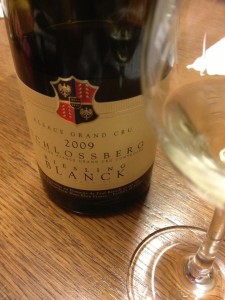

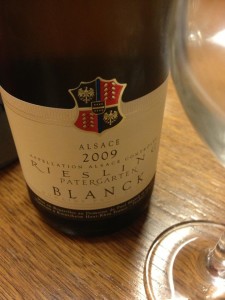
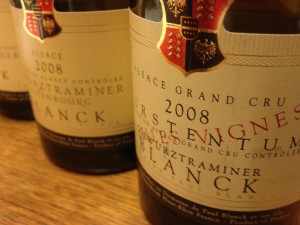
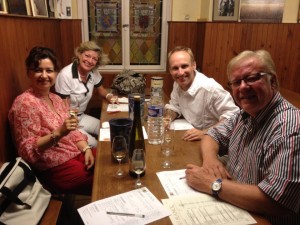
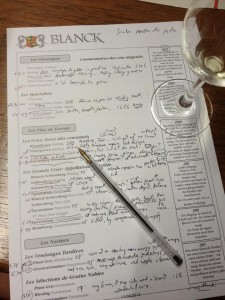
[…] […]
[…] […]